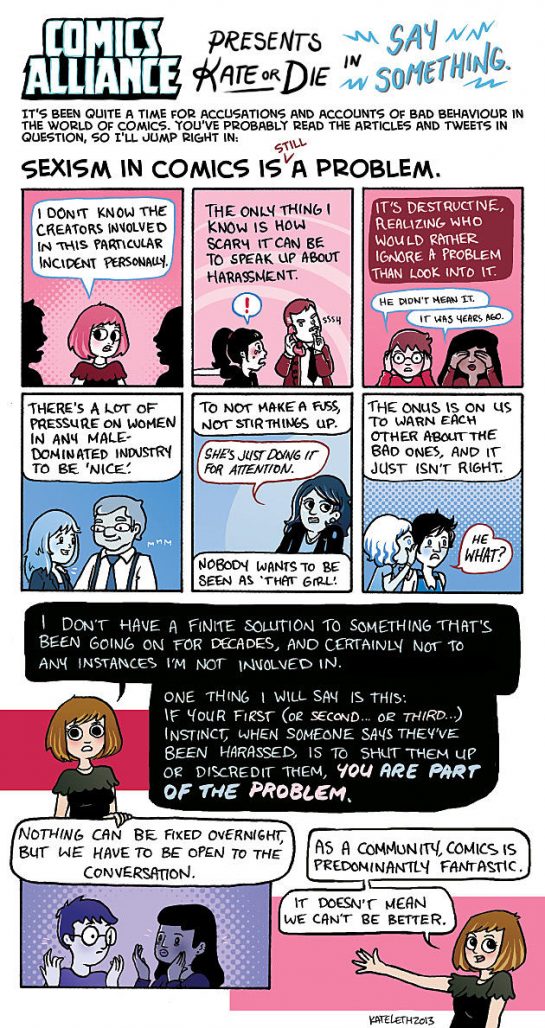Me Too. It was a rallying cry created by activist Tarana Burke nearly a decade ago. The hashtag #MeToo was resurfaced on Sunday October 15 by actress Alyssa Milano in the wake of the myriad of assault and harassment accusations against Hollywood titan, Harvey Weinstein. The goal of #MeToo is to demonstrate the pervasiveness of harassment and assault across all industries and professions.
If you’ve been sexually harassed or assaulted write ‘me too’ as a reply to this tweet. pic.twitter.com/k2oeCiUf9n
— Alyssa Milano (@Alyssa_Milano) October 15, 2017
The comics industry is no stranger to assault and harassment allegations. The industry has had numerous ‘open secrets’ regarding serial harassment and abuse. Below is a small selection of articles detailing the rampant racism and sexism in the industry since 2000.
- 2001: Writer Christopher J. Priest detailed (as he has done numerous times) the pervasiveness of racist and sexist attitudes in the comics industry. Something the late Dwayne McDuffie also spoke to about, especially during his time at Marvel in the 1980s.
- 2006: A series of sexual harassment allegations came to light when Colleen Doran and Lea Hernandez discussing the sexism they’ve faced.
- 2013: Cartoonist MariNaoimi wrote about being sexually harassed onstage at a comics convention by a fellow panelist.
- 2013: Joseph Hughes wrote about the lack of black writers at comics publishers and the silence from fans.
- 2013: Cosplayer Chaka-Cumberbatch detailed the racist attacks she received cosplaying Sailor Moon as a black female.
- 2014: Bitch Media details the results of a survey regarding sexual harassment and assault at various comics conventions.
- 2015: Alleged serial harasser and supporter of right wing, racist causes Nathan Edmondson was announced the writer of Red Wolf. A Native American character from Marvel. The announcement kicked off a series discussions about why the comics industry continues to support and employ individuals with known predatory behavior.
- 2015: Numerous harassment and assault allegations were levied against former Dark Horse Comics Editor-in-Chief Scott Allie.
- 2016: A series of sexual harassment allegations were made against numerous employees of DC Comics, including Eddie Berganza. These allegations came to light after DC made the decision to let go of Vertigo’s Shelly Bond.
- 2017: Buzzfeed News reports on a letter sent to over a dozen animation studios signed by over 200 women and gender nonconforming people calling for an end to sexism and sexual harassment in the animation industry.
- 2017: BleedingCool assembles a list of comics creators speaking out using #MeToo.
Okay, get the idea? Racism and harassment of all kinds are a massive and ongoing problem and have been since the industry began. It is an industry built largely on the exclusion of others. It’s important that racism and harassment are discussed together. Social psychologist at Rutgers University Diana Sanchez, recently published the results of a series of experiments which looked into how racism and sexism coexist. Of the study, Sanchez says:
“A great deal of psychological research examines whether racism and sexism coexist, and generally speaking this research finds that they do. […] But what we didn’t know was whether people in stigmatized groups perceived that to be true. Now we know that people perceive and experience stigma in ways that extend beyond their own group.”
Writing for Feministing, Executive Director of Know Your IX Mahroh Jahangiri writes about gendered violence and white supremacy. Jahangiri talks about the necessity of inclusion around conversations about assault and abuse. White women, she says, must confront and be held accountable for the harm they cause against other marginalized groups.
Writer Marcy Cook’s 2015 investigation on sexual harassment in the comics industry over at The Mary Sue chronicled sexual harassment claims and how the industry creates an environment which demands silence. A sentiment echoed in this 2015 post from writer Doctor Nerd Love, who makes the important addition that fans take their cues from creators.
Like a fire, toxic culture demands oxygen. It thrives on the willing complicity of peers and bystanders. Those who commit abuse and assault are always the ones who should be held responsible for their actions and harm of others. If the comics industry is serious about changing, it must suffocate the toxic sexist and racist attitudes which have lived for far too long.
Addressing harassment and abuse in all forms within the comics industry must go beyond expecting and/or requiring survivors of abuse and harassment to speak out. Here’s to the end of open secrets in the comic industry and every other place where racism and sexual harassment and abuse thrives.
Below is an incomplete list of a few resources and articles about race and harassment in comics and what we can do to stop it.
- Mashable: 5 crucial ways men can help end sexual assault
- Nicole Stamp: Advice for everyone in response to #MeToo
- Hofstra University: Graphic Prejudice in Comics
- NPR: Who Gets to Be A Superhero? Race and Identity in Comics
- The Mary Sue: Harassment in the Comics Industry, and How to End It
- Comics Alliance: Sexual Harassment in Comics, the Tipping Point
- Comics Alliance: Kate Leth’s Comic on Sexual Harassment (as seen below)






I quit one company when they wouldn’t do anything about sexual harassment. But not before helping ta female colleague take her story of harassment as far up the ladder as possible and, after it was all ignored, punching the harasser in the face. I know that kind of macho behavior isn’t the solution, but I’ll be damned if I let one of these harassers walk around untouched.
It disgusts me how many males stay quiet because they’re afraid of not getting a paycheck. Stand for something or fall for anything.
Sexual harassment/assault is a terrible problem but there are two questions everyone now talking about it needs to answer.
Did you support Bill Clinton? Did you support his chief enabler Hillary Clinton?
Mike
Comments are closed.